November 2006 LIP of the Month
Corresponds to event #24 in LIP record database.
Timescales of plume-lithosphere interactions in LIPs: 40Ar/39Ar geochronology of alkaline igneous rocks from the Paraná-Etendeka large igneous province
S. A. Gibson
Department of Earth Sciences, University of Cambridge, Downing Street, Cambridge, CB2 3EQ, UK.
e-mail: sally@esc.cam.ac.uk
For additional details and expanded discussion, see Gibson et al. (2006); Download pdf here.
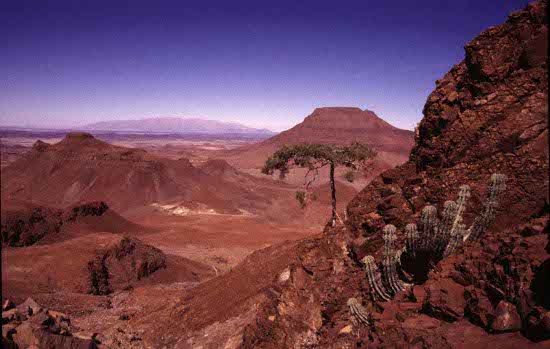
The Paraná-Etendeka LIP in NW Namibia
1. Abstract
High-precision 40Ar/39Ar ages for alkaline igneous rocks from the western margin of the Early-Cretaceous Paraná-Etendeka large igneous province (Paraguay) show that small-fraction melt generation occurred beneath the region in two phases; at 145 Ma and 127.5 Ma [1], i.e. before and at the end of the 139-127 Ma Paraná-Etendeka flood-basalt eruptions. Previously published 40Ar/39Ar ages for alkaline igneous rocks on the proto-Atlantic coastal margins range from 134 to 128 Ma and indicate that small-fraction melt generation in the east of the province was either synchronous or slightly later than the main pulse of tholeiitic volcanism (between 134 and 132 Ma). New 40Ar/39Ar phlogopite ages confirm that: (i) the earliest melts associated with the initial impact of the Tristan plume were generated in the west of the Paraná-Etendeka large igneous province and (ii) igneous activity was long lived and immediately predates continental break-up. The location and timing of both alkaline and tholeiitic melt generation in the Paraná-Etendeka province appear to have been significantly influenced by the non-uniform composition and thickness of the South American and south-west African lithosphere. The long duration of Paraná-Etendeka magmatism (17 Myr) relative to other Phanerozoic large igneous provinces (e.g. Siberia, Karoo, Deccan) may be an artefact of the limited available high-precision age data for CFB-related alkaline igneous rocks.
2. Introduction
The rates and timescales of emplacement of the vast volumes (1-4 million km3) of magma associated with large igneous provinces (LIPs) provide important constraints on the mechanisms of melt generation. Rapid eruption rates (i.e. over a few million years) reflect adiabatic decompression melting in the convecting mantle whereas a much longer duration of igneous activity (perhaps over 10’s of millions of years) is associated with lithospheric melting by heat conduction [2]. The Paraná-Etendeka LIP represents one of the world’s largest outpourings of basaltic magma (>1x106km3) but, despite the availability of high-precision 40Ar/39Ar dating techniques, the duration of tholeiitic volcanism has been the subject of considerable debate [3-7]. This is because tholeiitic melt generation in the Paraná-Etendeka province appears to have occurred over a larger time interval (~12 Myr [3]; Fig.1) than in other large igneous provinces, such as the Deccan (~7 Myr [8]) and Siberia (~5 Myr [9, 10]). The long duration of tholeiitic magmatism in the Paraná-Etendeka LIP has prompted suggestions that the mechanism of melt generation was different to that of other provinces [11, 12]. Recently published 40Ar/39Ar for the Karoo/Ferrar province, however, indicate that this may also have been emplaced over a long time span (~12 Myr [13-15]). Nevertheless, fine-grained basaltic rocks are notoriously difficult to date and it is unclear as to whether or not the wide range of ages determined for the Paraná-Etendeka province reflects the duration of magmatism or inaccuracies in dating techniques.
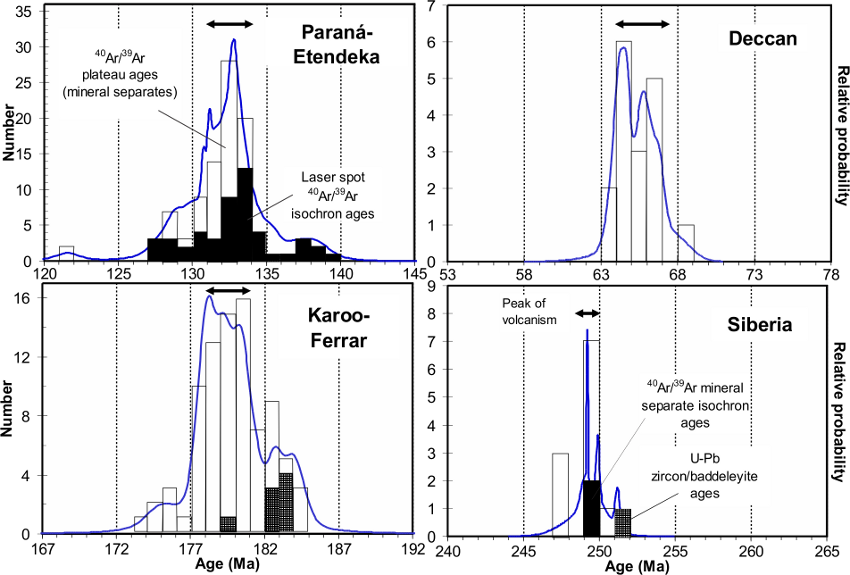
Figure 1: 40Ar/39Ar and U-Pb ages for tholeiitic rocks from Phanerozoic large igneous provinces. Published 40Ar/39Ar plateau age data have been filtered to remove: (i) whole-rock determinations; (ii) those calculated from steps containing <70% of the total 39Ar released. MSWD values of plotted samples are <2.6 (where given in the literature). All ages have been recalculated to a FCs monitor age of 28.02 [16]. Data sources are given in Gibson et al. [1].
3. Age of Paraná-Etendeka magmatism
The Early-Cretaceous Paraná-Etendeka large igneous province outcrops over an area of 1.2x106 km2 (Fig. 2).
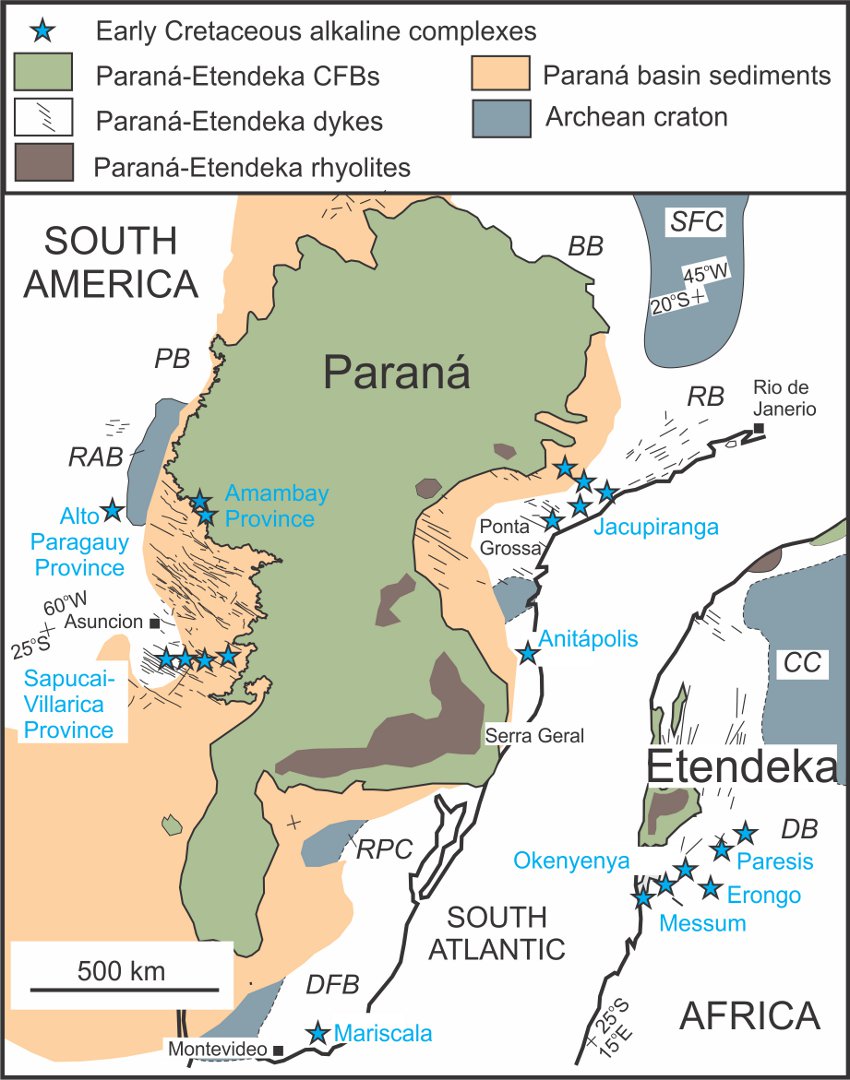
Figure 2: Distribution of alkaline and tholeiitic igneous rocks in the Paraná-Etendeka large igneous province prior to continental break-up. Modified from Stewart et al. [5] to additionally show Early Cretaceous alkaline igneous rocks [17] and also the approximate locations of cratons and mobile belts [18]. Dyke locations in Paraguay are from [19]. Abbreviations are as follows: BB, Brasilia Belt; DB, Damara Belt; DFB, Dom Feliciano Belt; PB, Paraguai Belt; RB, Ribeira Belt; CC, Congo Craton; LA; Luis Alves Craton; RAB, Rio Apa Block; RPC, Rio de la Plata Craton; SFC, São Francisco Craton.
High-precision 40Ar/39Ar ages are available for ~100 samples of tholeiitic rocks (flood-basalts and rhyolites [3-7, 20-26]). Only 6 samples have yielded ages >136 Ma (Fig. 1) and 4 of these are from the west of the province. All of these ‘old’ ages were estimated from inverse-isochron plots of 40Ar/39Ar laser-spot step-heating analyses of plagioclase grains [3, 5] but consistently younger plateau ages (<132 Ma) have been determined on other samples using furnace step-heating and a defocused 40Ar/39Ar laser ([4, 6, 21, 23-26]; Fig. 1). The ‘young’ 40Ar/39Ar plateau ages are for samples collected from the continental margins of South America (Serra Geral escarpment and the Ponta Grossa and coastal dyke swarms [4, 24, 26] and southern Africa (Etendeka province and Angola [6]; Fig. 2). It is unclear, therefore, as to whether the variations in ages (and hence time-spans of magmatism) are due to differences in analytical techniques and/or sites of sample locations.
Only a few reliable 40Ar/39Ar plateau ages have been published for alkaline igneous rocks from the Paraná-Etendeka province and they are mainly for samples from the central (coastal margins of Uruguay and Brazil) and eastern part (Damaraland, Namibia) [5, 25, 27-30]. These range from 134 to 127.5 Ma (see below) and, together with stratigraphic relationships, suggest that alkaline igneous activity was broadly contemporaneous with or slightly postdates the tholeiitic magmatism. Nevertheless, field relations indicate that alkaline igneous activity in eastern Paraguay (Fig. 3 & 4), which is located on the western margin of the Paraná-Etendeka province (Fig. 2), both pre- and post dates CFB emplacement.
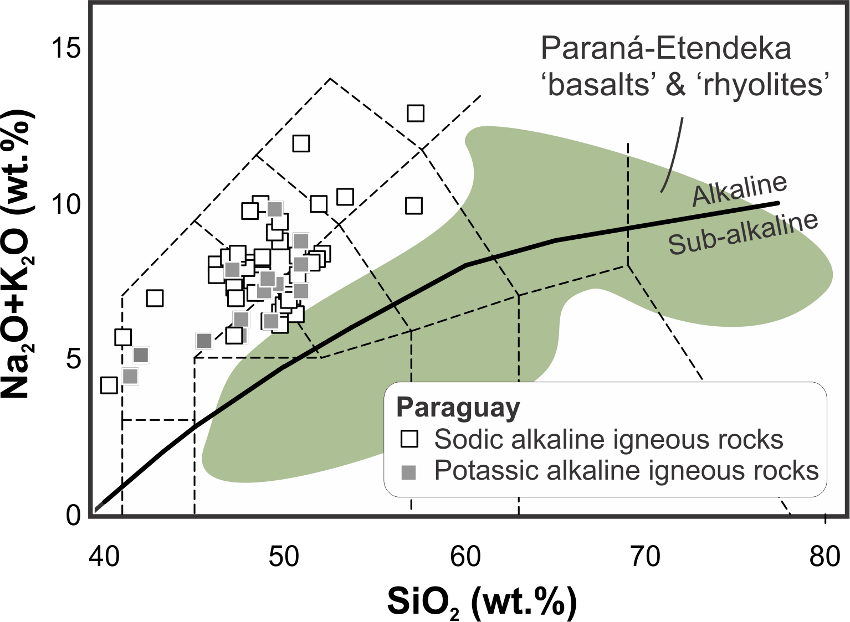
Figure 3: Total alkalis versus silica plot for Early-Cretaceous magmas from eastern Paraguay. The field of Paraná-Etendeka CFBs and their fractionates is shown for comparison. Solid line shows the divide between alkaline and sub-alkaline igneous rocks after Macdonald & Katsura [31] and the dashed lines show boundaries of IUGS fields after Le Maitre [32]. Data sources are: [1, 33-35].
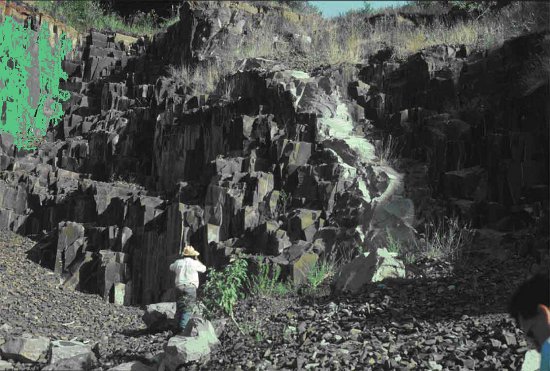
Figure 4: Quarry exposure at Taquarita, Eastern Paraguay shows a lamprophyre dyke cross cutting Paraná CFB lavas
3.1 Age of Paraná-Etendeka related alkaline magmatism in Paraguay
3.1.1 K/Ar ages
Conventional K/Ar whole-rock and mineral ages for Paraguayan alkaline igneous rocks range from 66 to 183.5 Ma [36-39]. The large age range reflects loss and excess of 40Ar during weathering and assimilation of mantle-derived 40Ar, respectively. Some of these effects can be eliminated by focusing only on ages determined for fresh biotite/phlogopite separates which have >7 wt.% K. This filtered K/Ar dataset suggests that Paraguayan alkaline magmatism occurred between 146.7±9.2 to 124.6±4.2 Ma.
3.1.2 40Ar/39Ar ages
40Ar/39Ar age determinations were undertaken on phlogopite separates from 6 lamprophyres and 1 trachyte, collected from the three Early-Cretaceous alkaline igneous provinces in eastern Paraguay (Fig. 5).
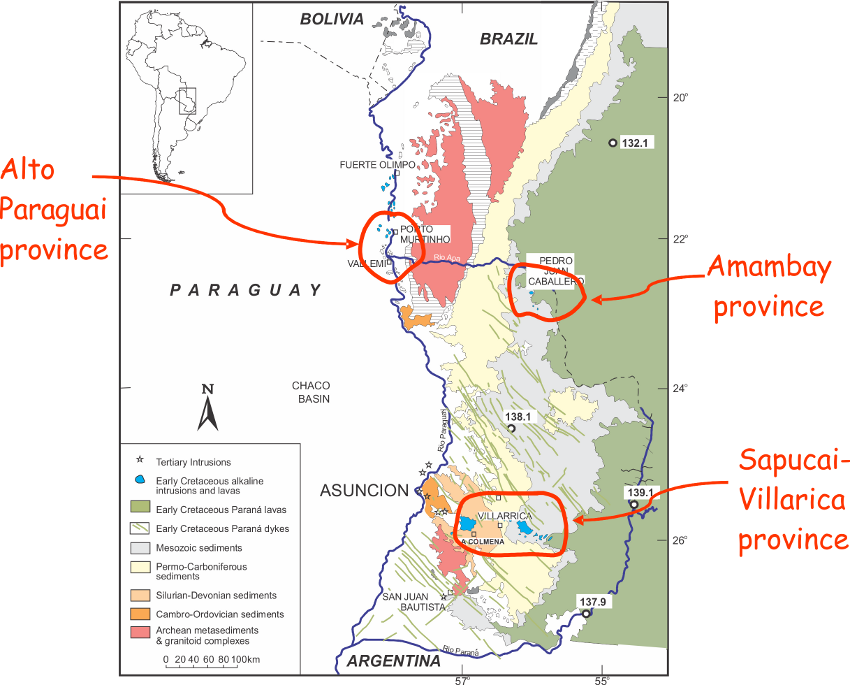
Figure 5: Location of Cretaceous alkaline igneous provinces in Paraguay. Localities of samples of Paraná dykes previously dated by 40Ar/39Ar laser spot step-heating are shown by open circles together with their published ages (in millions of years). 40Ar/39Ar age data are from [3, 5]
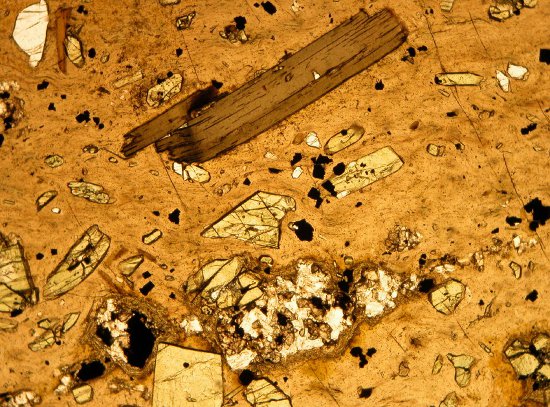
Figure 6: Photomicrograph of a lamprophyre dyke in eastern Paraguay that has entrained a small xenolith of Paraná basalt (lower centre of image). Note the fresh glassy groundmass and euhedral biotite phenocryst. Width of field of view is 4 mm.
Samples were selected on the basis of petrographic freshness and because they contained euhedral, phlogopite/biotite phenocrysts (Figure 6). Phlogopites were hand picked from crushed material (200-500μ) and subsequently sealed in air, in quartz vials, and irradiated for 16 h in the CLICIT facility of the Oregon State University TRIGA reactor. 40Ar/39Ar step-heating analyses were performed by M. Pringle at the NERC Argon Isotope Facility at Scottish Universities Environmental Research Centre using a very low-blank, double-vacuum-resistance furnace for the phlogopite step-heating experiments and a CW Nd–YAG laser for the sanidine total-fusion analysis.
Table 1: 40Ar/39Ar ages determined on phlogopite separates from Paraguayan alkaline igneous rocks
|
Locality |
Sample No |
Rock type |
Plateau age (Ma, ±2σ)
|
MSWD |
No of steps
|
Total 39Ar released (%) |
Isochron age (Ma, ±2σ)
|
J value |
Plateau age (Ma) recalculated to
FCs=28.02 Ma [45]
|
|
Alto Paraguay |
|
|
|
|
|
|
|
|
|
|
Valle Mi |
93SOB115 |
Lamprophyre |
156.40±2.07 |
17.62 |
3 |
70.5 |
155.75±4.39 |
0.0051 |
158.67 |
|
|
|
|
|
|
|
|
|
|
|
|
Amambay |
|
|
|
|
|
|
|
|
|
|
Arroyo Gasory |
93SOB124 |
Trachyte |
142.92±0.89 |
1.7 |
8 |
85.8 |
141.07±2.3 |
0.00509 |
144.99 |
|
Cerro Sarambi |
93SOB143a |
Lamprophyre |
142.88±0.93 |
1.14 |
7 |
87.2 |
141.90±1.2 |
0.01112 |
144.95 |
|
Cerro Sarambi |
93SOB143b |
Lamprophyre |
142.89±0.93 |
1.6 |
7 |
73.5 |
142.00±2.2 |
0.01128 |
144.96 |
|
|
|
|
|
|
|
|
|
|
|
|
Sapucai Villarica |
|
|
|
|
|
|
|
|
|
|
Sotu-Rugua |
93SOB3a |
Lamprophyre |
126.08±0.79 |
0.41 |
8 |
88.1 |
126.19±0.83 |
0.01131 |
127.91 |
|
Sotu-Rugua |
93SOB3b |
Lamprophyre |
125.84±0.79 |
0.64 |
9 |
100 |
125.81±0.83 |
0.01115 |
127.66 |
|
Canada 1 |
93SOB46 |
Lamprophyre |
125.31±0.78 |
2.6 |
6 |
84.9 |
125.70±1.8 |
0.00511 |
127.12 |
|
Tacuarita |
93SOB63 |
Lamprophyre |
128.20±1.40 |
18 |
8 |
75.3 |
128.80±1.90 |
0.0051 |
130.09 |
|
Catalan |
93SOB106 |
Lamprophyre |
127.60±0.79 |
4.5 |
9 |
61.1 |
127.50±1.20 |
0.00511 |
129.45 |
Full analytical results are given in Gibson et al. [1]
Bold font denotes preferred ages
Plateau age includes 2σ j-error of 0.6%
All of the 7 samples produced stratigraphically consistent ages but excess argon has been identified in one of these. The argon release spectra of the only sample from the Alto Paraguay alkaline igneous province (93SOB115, [1]) shows high apparent ages at low temperatures and the ‘plateau’ is defined by only 3 steps which represent 70.5% of the cumulative 39Ar released [1]. The plateau age of 158.67±2.07 has a very high MSWD (17.62, Table 1) and we do not consider this to represent a reliable crystallisation age for the rock. This 40Ar/39Ar age is significantly older than those determined for other Paraguayan alkaline igneous rocks and is also older than previously determined conventional K/Ar phlogopite ages for the Vallemi dykes of 143±2 Ma (Gibson, Thompson, Mitchell unpubl. data) and 137.4±5.4 Ma [40].
All of the other samples produced relatively undisturbed spectra and yielded well-defined plateaux with >75% of the total 39Ar released [1]. Two dykes from the Amambay alkaline igneous province (93SOB124 and 143) gave reliable 40Ar/39Ar plateau ages of 144.99±0.89 Ma and 144.95±0.93 Ma. The weighted average age for the Amambay alkaline igneous province of 144.97±0.63 Ma is within the range of conventional K/Ar dates for fresh biotite/phlogopite separates from Cerro Chiriguelo, Cerro Sarambi and Arroyo Gasory (135±7 Ma to 147±9 Ma [38, 40, 41]) but error bars for the 40Ar/39Ar ages are significantly less.
Despite the fact that all 40Ar/39Ar plateau consisted of >75% of the total 39Ar released, age estimates for only three of the five phlogopite separates from the Sapucai-Villarica province had MSWD values <2.6. Phlogopite separates from the Sotu-Ruguá (Cerro Santa Tomas) dyke (93SOB3) yielded 40Ar/39Ar plateau ages of 127.91±0.79 Ma (MSWD=0.69) and 127.66±0.79 Ma (MSWD=0.41) and phlogopite from Canada 1 (93SOB46) gave a 40Ar/39Ar plateau age of 127.12±0.78 Ma (MSWD=2.61). The weighted mean of these three ages is 127.56±0.45 Ma. Sample 93SOB63 and 106 have ‘humped’ spectra (Supplementary Figure), showing Ar loss at low temperature and Ar recoil effects at high temperatures. These yielded plateau ages of 130.09±1.40 Ma and 129.45±0.79 Ma with MSWDs of 18.0 and 4.5, respectively. Previous conventional K/Ar ages for biotite/phlogopite separates (with K> 7 wt.%) from the Sapucai-Villarica province ranged from 124.6±8.4 Ma to 132.9±10.10 Ma. A similar 40Ar/39Ar plateau age of 127.56 Ma has also been quoted for Cerro Santa Tomas ([25] recalculated to FCs=28.02).
4. Comparison with previously determined 40Ar/39Ar ages for Paraná-Etendeka magmas
The new 40Ar/39Ar ages suggest that Early-Cretaceous alkaline igneous activity in the Paraná-Etendeka province occurred over a longer period of time (17 Myr) than has previously been established from published high-precision 40Ar/39Ar and U-Pb ages.
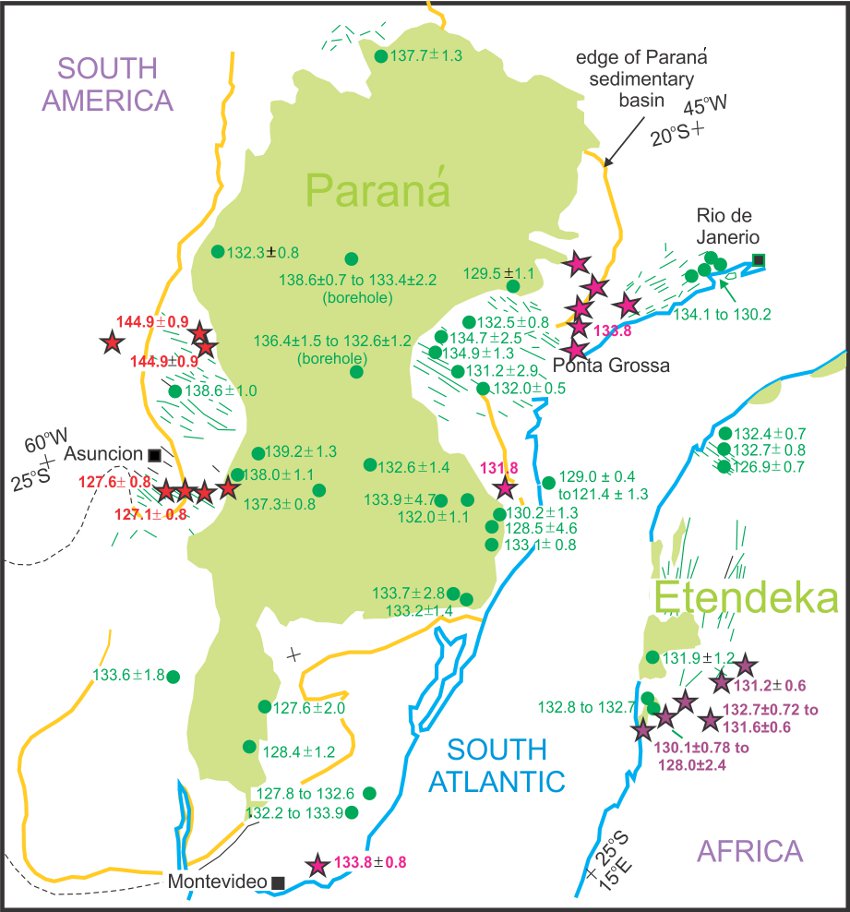
Figure 7: Spatial variation of high-precision 40Ar/39Ar ages determined for alkaline (shown in red/purple font) and tholeiitic rocks (green font) from the Paraná-Etendeka large igneous province [1, 3-7, 20-23, 25-27, 29, 30, 42, 43].
4.1.1 Alkaline igneous rocks
Whole-rock 40Ar/39Ar and U-Pb age determinations are available for Early-Cretaceous alkaline igneous intrusive complexes from Damaraland (north-west Namibia, Fig. 2). Contact relations indicate that, on the eastern fringe of the Paraná-Etendeka province, most of the alkaline intrusives post-date the CFB lavas. A 40Ar/39Ar whole-rock plateau age of 138.00±0.8 Ma (MSWD=0.73) has been reported for a comendite flow from Paresis ([30]) but this age is stratigraphically inconsistent with the 40Ar/39Ar K-feldspar plateau age of 131.44±0.6 Ma (MSWD=1.16) determined for an underlying quartz-feldspar-porphyry flow [44]. Furthermore, the Paresis alkaline complex postdates the eruption of the Etendeka flood basalts which are believed to have been emplaced <134 Ma (see below). Field relationships indicate that the alkaline plugs of the Erongo complex (Fig. 2) also postdate the Etendeka flood basalts; a biotite separate from one of these gave an 40Ar/39Ar plateau ages of 131.48±2 Ma [27]. The youngest published 40Ar/39Ar age for CFB-related alkaline magmatism in north-west Namibia is for the Messum complex. Biotite separates from late syenites gave an 40Ar/39Ar isochron age of 127.86±2.4 Ma. An Rb-Sr age of 126.6 Ma has been determined for the Okenyenya complex but this has a 2σ error of ±7.3 Ma [30, 45].
40Ar/39Ar ages for alkaline magmatism on the southern Brazilian and Uruguayan coastal margins (e.g. Jacupiranga, Anitapolis, Mariscala, Fig. 2) range from 133.7 to 131.8 Ma [5, 25, 30, 42]. These complexes are similar in age to the spatially associated tholeiitic flows but are distinct from a later phase of alkaline magmatism.
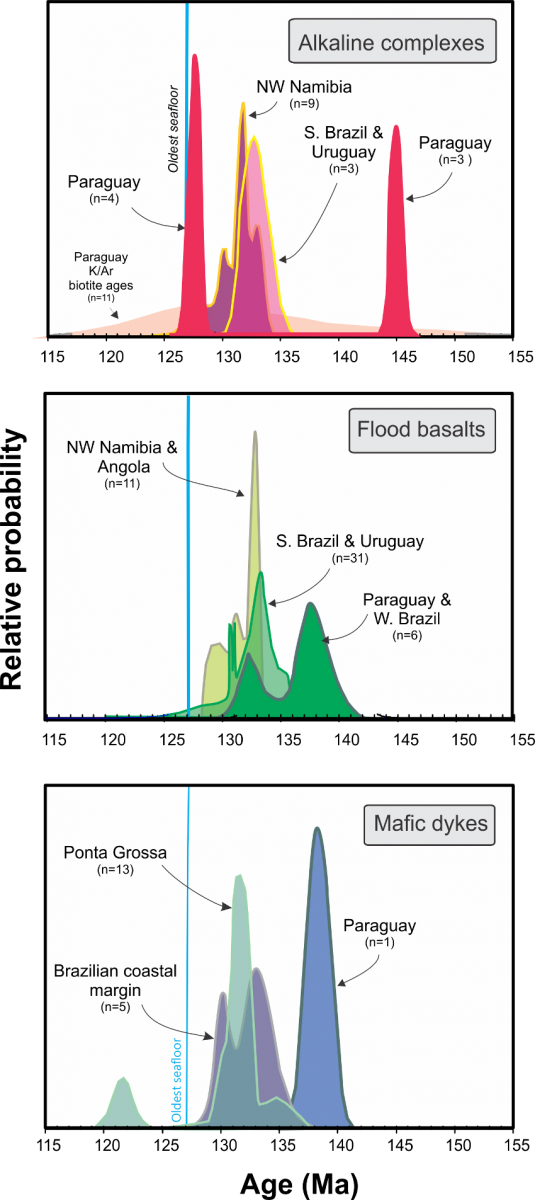
Figure 8: Age-probability density plots for alkaline and tholeiitic magmas from the Paraná-Etendeka large igneous province. With the exception of K/Ar biotite/phlogopite ages for Paraguayan alkaline complexes, all other ages are 40Ar/39Ar and were determined by furnace step-heating of plagioclase or biotite/phlogopite grains or laser-spot step-heating and have been corrected to TCRs=28.02 Ma [16]. Published age data have been filtered to remove: (i) plateau ages calculated from steps containing <70% of the total 39Ar released and (ii) ages with MSWD >2.6. The age of the oldest seafloor at this latitude (127 Ma) is shown for reference [46]. K/Ar ages are for biotite/phlogopite separates containing >7 wt.% K [36, 38, 40, 41]. 40Ar/39Ar phlogopite plateau ages for Paraguayan rocks are from Table 1 which is reproduced from [1]. Additional data are from [3-7, 21, 23-27, 29, 30, 42-44].
4.1.2 Continental-flood basalts and rhyolites
The first phase of alkaline magmatism in the Paraná-Etendeka province pre-dates the earliest tholeiitic magmatism by ~6 Ma. 40Ar/39Ar ages suggest that the flood basalts were erupted over a 12 Ma time interval, between 139.1 and 127.5 Ma, with the main pulse of tholeiitic magmatism between approximately 134 and 132 Ma (Fig. 8 [3-5, 22, 24]). Importantly, the oldest ages available for both the alkaline and tholeiitic volcanism are almost all from the west of the province (Fig. 7). The youngest phase of alkaline magmatism in eastern Paraguay was approximately contemporaneous with the emplacement of the youngest flood basalts, which occur on or near the Brazilian and Uruguayan coastal margins and the end of silicic volcanism at 127.7 Ma [3, 5-7, 26, 27].
40Ar/39Ar age determinations for tholeiites from the NW/SE trending Ponta Grossa dyke swarm (Figs. 7 & 8) and the coast-parallel dyke swarm of south-east Brazil suggest that major lithospheric extension occurred between 135 Ma and 130 Ma but may have continued to 121.5±1.3 Ma [3, 24, 26, 42]. The onset of dyke emplacement predates the formation of the oldest South Atlantic sea floor (Chron 4, 127 Ma [46]) at this latitude by ~8 Ma. A NW/SE trending tholeiitic dyke from the eastern Paraguay swarm gave an 40Ar/39Ar age of 138.1±2 Ma [5], which suggests that the onset of lithospheric extension may, in fact, have occurred in the western part of the CFB province.
5. Comparison with timescales of formation of other large igneous provinces
It has recently become apparent, from high precision 40Ar/39Ar and U-Pb age determinations, that the duration of tholeiitic volcanism in LIPs is much longer than was previously thought, e.g. [15, 47]. Nevertheless, in most well-dated provinces >80% of the volume of the CFB lavas appears to have been emplaced in just a few million years (Fig. 1). This suggests that significant upwelling and melting of plume starting-heads only occurs for 2 to 3 Myr. This may relate to the time interval when the upwelling plume is located beneath thin lithosphere, and that the subsequent drift of thicker lithosphere over the plume head may ‘switch off’ large-degree melting at a given location. Such a hypothesis is supported by studies from the Karoo-Ferrar LIP (e.g.[15]) which show that, as in the Paraná-Etendeka, the location of tholeiitic melt generation varied with time.
Despite the fact that volatile-rich, alkaline-igneous activity has been observed in almost all Phanerozoic LIPs, only a few high-precision ages have been published. These suggest that, with the exception of the Paraná-Etendeka LIP, small-fraction melt generation both pre- and post-dates the peak of tholeiitic volcanism by up to 3 Myr. For example, in the Deccan province, 40Ar/39Ar mineral ages for alkaline igneous rocks range from 68.53 to 64.64 Ma ([48] Gibson & Widdowson unpublished data) whereas the main pulse of tholeiitic magmatism occurred between 65 and 65.4 Ma [8, 48-50]. In the Karoo-Ferrar province, 40Ar/39Ar and U-Pb mineral age determinations suggest that volatile-rich alkaline igneous activity occurred at a similar time (181.9 to 178.1 Ma [51, 52]) to the main pulse of tholeiitic magmatism (183.5 and 179 Ma [53]). This is also true for the Siberian LIP in which melanephelinites and carbonatites have U-Pb ages between 251.7 and 250.2 Ma [9] and 40Ar/39Ar mineral age determinations suggest the main pulse of tholeiitic volcanism occurred between 251.2 and 249.1 Ma [10, 54]. The large time interval (~11 Myr) that separates early alkaline igneous activity from the peak of tholeiitic volcanism in the Paraná-Etendeka LIP may reflect the widespread presence of thick lithosphere at the time of plume impact or may indeed be an artefact of the limited number of 40Ar/39Ar ages that are available for alkaline igneous rocks from other LIPs. The absence of ‘old’ ages for alkaline magmas from LIPs may be due to the susceptibility of early-phase small-fraction volatile-rich melts to burial by thick successions of tholeiitic basalts and it may be extremely fortunate that we have been able to sample these in the Paraná-Etendeka LIP.
6. Conclusions
(i) High-precision 40Ar/39Ar age determinations of volatile-rich alkaline igneous rocks in eastern Paraguay indicate that small-fraction melt generation occurred in two discrete episodes at 145 and 127.5 Ma. The earliest phase of this alkaline igneous activity pre-dates that from elsewhere in the Paraná-Etendeka large igneous province by at least 11 Myr. The youngest phase (127.5 Ma) is similar in age to the oldest sea floor at these latitudes [46].
(ii) In the Paraná-Etendeka province, the early phase of both alkaline and tholeiitic igneous activity occurred in the west. Alkaline igneous activity predates tholeiitic volcanism by 6 Myr. The sequence and timescale of igneous activity in this large igneous province is consistent with the findings of laboratory experiments and numerical models undertaken to simulate the impact of mantle plume starting heads.
(iii) The total duration of igneous activity in the Paraná-Etendeka province appears to have been much greater than that in other Phanerozoic LIPs, such as the Deccan and Siberia. There are, however, significantly more high-precision ages published for the Paraná-Etendeka province (Fig. 1) and the long duration of igneous activity may be an artefact of the available ages rather than a consequence of different melt-generation processes associated with impacting mantle-plume starting-heads.
(iv) Despite the fact that volatile-rich, alkaline-igneous activity has been observed in almost all Phanerozoic LIPs, only a few high-precision ages have been published. These suggest that, with the exception of the Paraná-Etendeka LIP, small-fraction melt generation both pre- and post-dates the peak of tholeiitic volcanism by up to 3 Myr [8, 9, 48, 52, 55]. The large time interval (~11 Myr) that separates early alkaline igneous activity from the peak of tholeiitic volcanism in the Paraná-Etendeka LIP may reflect the widespread presence of thick lithosphere at the time of plume impact. The absence of ‘old’ ages for alkaline magmas from LIPs may be due to the susceptibility of early-phase small-fraction volatile-rich melts to burial by thick successions of tholeiitic basalts and it may be extremely fortunate that we have been able to sample these in the Paraná-Etendeka LIP.
Acknowledgements
Research on Paraguayan alkaline igneous rocks formed part of a larger study on South American small-fraction melts with R.N. Thompson which was funded by NERC (GR3/8084), the British Council, Durham and Cambridge Universities. 40Ar/39Ar analyses were funded by NERC (IP/454/0995) and undertaken at SUERC by Malcolm Pringle and Jim Imlach.
References
[1] S.A. Gibson, R.N. Thompson, J.A. Day, Timescales and mechanisms of plume-lithosphere interactions: 40Ar/39Ar geochronology and geochemistry of alkaline igneous rocks from the Parana-Etendeka large igneous province, Earth and Planetary Science Letters 251(2006) 1-17.
[2] R.S. White, McKenzie, D.P., Mantle plumes and flood basalts, Journal of Geophysical Research 100(1995) 17543-17585.
[3] S.P. Turner, Regelous, M., Kelley, S., Hawkesworth, C.J. and Mantovani, M. S.M., Magmatism and continental break-up in the South Atlantic: high precision 40Ar-39Ar geochronology, Earth and Planetary Science Letters 121(1994) 333-348.
[4] P.R. Renne, Ernesto, M., Pacca, I.G., Coe, R.S., Glen, J.M., Prevot, M. and Perrin, M., The age of Paraná flood volcanism, rifting of Gondwanaland, and the Jurassic-Cretaceous boundary, Science 258(1992) 975-979.
[5] K. Stewart, Turner, S., Kelley, S., Hawkesworth, C., Kirstein, L. and Mantovani, M., 3-D, 40Ar/39Ar geochronology in the Paraná continental flood basalt province, Earth and Planetary Science Letters 143(1996) 95-109.
[6] P.R. Renne, Glen, J. M., Milner, S. C. and Duncan, A. R., Age of Etendeka flood volcanism and associated intrusions in southwestern Africa, Geology 24(1996) 659-662.
[7] L.A. Kirstein, Kelley, S., Hawkesworth, C., Turner, S., Mantovani, M. and Wijbrans, J., Protracted felsic magmatic activity associated with the opening of the South Atlantic, Journal of the Geological Society of London 158(2001) 583-592.
[8] C. Hofmann, Féraud, G. and Courtillot, V., 40Ar/39Ar dating of mineral separates and whole rocks from the Western Ghats lava pile: further constraints on duration and age of the Deccan traps, Earth and Planetary Science Letters 180(2000) 13-27.
[9] S.L. Kamo, Czamanske, G.K., Amelin, Y., Fedorenko, V.A., Davis, D. W. and Trofimov, V. R., Rapid eruption of Siberian flood-volcanic rocks and evidence for coincidence with the Permian-Triassic boundary and mass extinction at 251 Ma, Earth and Planetary Science Letters 214(2003) 75.
[10] M.K. Reichow, Saunders, A.D., White, R.V., Pringle, M.S., Al'Mukhamedov, A.I., Medvedev, A.I. and Kirda, N.P., 40Ar/39Ar dates from the West Siberian Basin: Siberian flood basalt province doubled, Science 296(2002) 1846-1849.
[11] C.J. Hawkesworth, Gallagher, K., Kirstein, L., Mantovani, M. S. M., Peate, D. W. and Turner, S. P., Tectonic controls on magmatism associated with continental break-up: an example from the Paraná-Etendeka Province, Earth and Planetary Science Letters 179(2000) 335-349.
[12] S. Turner, Hawkesworth, C., Gallagher, K., Stewart, K., Peate, D, and Mantovani, M., Mantle plumes, flood-basalts, and thermal models for melt generation beneath continents: assessment of a conductive heating model and application to the Paraná, Journal of Geophysical Research 101(1996) 11503-11518.
[13] A.R. Duncan, Hooper, P.R., Rehacek, J., Marsh, J.S. and Duncan, A.R., The timing and duration of the Karoo igneous event, southern Gondwana, Journal of Geophysical Research 102(1997) 18127-18138.
[14] T.R. Riley, Knight, K.B., Review of pre-break-up Gondwana magmatism, Antarctic Science 13(2001) 99-110.
[15] F. Jourdan, Feraud, G., Bertrand, H., Kampunzu, Ali B., Tshoso, G., Watkeys, M.K. and Le Gall, B., Karoo large igneous province: Brevity, origin, and relation to mass extinction questioned by new 40Ar/39Ar age data, Geology 33(2005) 745-748.
[16] P.R. Renne, Swisher, C. C., Deino, A. L., Karner, D. B., Owens, T. L. and DePaolo, D. J., Intercalibration of standards, absolute ages, and uncertainties in 40Ar/39Ar dating, Chemical Geology 145(1998) 117–152.
[17] H.H.G.J. Ulbrich, Gomes, C.B., Alkaline rocks from continental Brazil, Earth Science Reviews 17(1981) 135-154.
[18] J.A. Snoke, James, D. E., Lithospheric structure of the Chaco and Paraná basins of South America from surface-wave inversion, Journal of Geophysical Research 102(1997) 2939-2951.
[19] M.D. Drueker, Gay, S.P., Mafic dyke swarms associated with Mesozoic rifting in eastern Paraguay, South America, Mafic dyke swarms 34, Geological Association of Canada Special Publication, 1987, pp. 187-193.
[20] K. Deckart, Feraud, G., Marques, L.S. and Bertrand, H., New time constraints on dyke swarms related to the Paraná-Etendeka magmatic province and subsequent South Atlantic opening, southeastern Brazil, Journal of Volcanology and Geothermal Research 80(1998) 67-83.
[21] M. Ernesto, Raposo, M.I.B., Marques, L.S., Renne, P. R., Diogo, L.A. and de Min, A., Paleomagnetism, geochemistry and 40Ar/39Ar dating of the north-eastern Paraná magmatic province: tectonic implications, J. Geodyn. 28(1999) 321-340.
[22] C. Hawkesworth, Gallagher,K., Kelley, S., Mantovani, M., Peate, D.W., Regelous, M. and Rogers, N.W., Paraná magmatism and the opening of the South Atlantic 68, Geological Society of London Special Publication, 1992, pp. 221-240.
[23] A. Marzoli, L. Melluso, V. Morra, P.R. Renne, I. Sgrosso, M. D'Antonio, L.D. Morais, E.A.A. Morai, and, G. Ricci, Geochronology and petrology of Cretaceous basaltic magmatism in the Kwanza basin (western Angola), and relationships with the Paraná-Etendeka continental flood basalt province, J. Geodyn. 28(1999) 341-356.
[24] M.I.B. Raposo, Ernesto, M. and Renne, P. R., Paleomagnetism and 40Ar/39Ar dating of the early Cretaceous Florianopolis dike swarm (Santa Catarina Island), Southern Brazil, Phys. Earth Planet. Inter. 108(1998) 275-290.
[25] P.R. Renne, Mertz, D.F., Ernesto, M., Marques, L.S., Teixeira, W., Ens, H.H., Richards, M.A., Geochronologic constraints on magmatic and tectonic evolution of the Paraná Province, EOS Trans. AGU (Abstract)(1993) 553.
[26] P.R. Renne, Deckart, K., Ernesto, M., Feraud, G. and Piccirillo, E. M., Age of the Ponta Grossa dike swarm (Brazil), and implications to Paraná flood volcanism, Earth and Planetary Science Letters 144(1996) 199-211.
[27] M. Wigand, Schmitt, A. K.,Trumbull, R. B.,Villa, I. W. and Emmermann, R., Short-lived magmatic activity in an anorogenic subvolcanic complex: 40Ar/39Ar and ion microprobe U-Pb zircon dating of the Erongo, Damaraland Province, Namibia, Journal of Volcanology and Geothermal Research 130(2004) 285-305.
[28] V.F. Velázquez, Gomes, C.B., Capaldi, G., Comin-Chiaramonti, P., Ernesto, M., Kawashita, K., Petrini, R. and Piccirillo, E.M., Magmatismo alcalino mesozóico na porção centro-oriental do Paraguai: aspectos geocronológicos, Geochimica Brasil 6(1992) 23–35.
[29] A.R. Basu, Renne, P.R., Mertz, D. and Poreda, R.J., Alkaline igneous rocks of the Deccan and Paraná: implications for the origin of continental flood basalts (CFB), EOS Trans. AGU (Abstract)(1993) 552.
[30] S.C. Milner, le Roex, A. P. and O’Connor, J. M., Age of Mesozoic igneous rocks in northwestern Namibia, and their relationship to continental breakup, Journal of the Geological Society of London 152(1995) 97–104.
[31] G.A. Macdonald, Katsura, T, Chemical composition of Hawaiian lavas, Journal of Petrology 5(1964) 82-133.
[32] R.W. Le Maitre, Igneous Rocks: A Classification and Glossary of Terms: Recommendations of the International Union of Geological Sciences Subcommission on the Systematics of Igneous Rocks, 2002, 240 pp.
[33] D.W. Peate, Stratigraphy and petrogenesis of the Paraná continental flood-basalts, southern Brazil, Unpublished Ph.D thesis, Open University, UK, 1990.
[34] S.A. Gibson, Thompson, R.N., Dickin, A.P., and Leonardos, O.H., High-Ti and low-Ti mafic potassic magmas: key to plume-lithosphere interactions and continental flood-basalt genesis, Earth and Planetary Science Letters 136(1995) 149-165.
[35] R.N. Thompson, Gibson, S.A. and Dickin, A.P., Early Cretaceous basalt and picrite dykes of the southern Etendeka region, NW Namibia: windows into the role of the Tristan mantle plume in Paraná-Etendeka magmatism, Journal of Petrology 42(2001) 2049-2081.
[36] P.R. Bitschene, Mesozoicher und Kanozoischer anorogener magmatismus in Ost Paraguay: arbeiten zur geologie und petrologie zweier alkali provinzen, unpublished PhD thesis, Heidelberg University, 1987.
[37] J.H. Palmieri, Arribas, A., El complejo alcalino potasico de Sapucai (Paraguay Oriental). Congresso Ibero-Amer Geol Econ 2(1975) 267-300.
[38] I.K. Sonoki, Garda, G.M., Idades K-Ar de rochas alcalinas do Brasil meridional e Paraguai oriental: compilacão e adaptacão as novas constantes de decaimento, Boletin IG-USP 19(1988) 63-85.
[39] V.F. Velázquez, Provincia alcalina central Paraguai centro-oriental: aspectos tectonicos, petrographicos e geochronologicos, MSc, São Paulo, 1992.
[40] F. Castorina, Censi, P., Comin-Chiaramonti, P., Piccirillo, EM., Alcover Neto, A., Gomes, C.B., Ribeiro de Almeida, T.I., Speziale, S. and Toledo, C.M., Carbonatites from Eastern Paraguay and genetic relationships with potassic magmatism: C, O, Sr and Nd isotopes, Mineralogy and Petrology 61(1997) 237-260.
[41] G.N. Eby, Mariano, A. N., Geology and geochronology of carbonatites and associated alkaline rocks peripheral to the Paraná Basin, Brazil-Paraguay, Journal of South American Earth Sciences 6(1992) 207-216.
[42] M. Regelous, Geochemistry of dolerites from the Paraná flood basalt province, southern Brazil, Unpublished PhD thesis, Open University, 1993.
[43] A.K. Schmitt, Emmermann, R., Trumbull, R. B. Buhn, B. and Henjes-Kunst, F., Petrogenesis and 40Ar/39Ar Geochronology of the Brandberg Complex, Namibia: Evidence for a major mantle contribution in metaluminous and peralkaline granites, Journal of Petrology 41(2000) 1207-1239.
[44] F. Pirajno, Phillips, D. and Armstrong, R.A., Volcanology and eruptive history of the Erongo Volcanic Complex and the Paresis Igneous Complex: implications for mineral deposit styles, Communications of the Geological Survey of Namibia 12(2000).
[45] S.C. Milner, le Roex, A. P. and Watkins, R.T., Rb-Sr determinations of rocks from the Okenyenya igneous complex, northwestern Namibia, Geological Magazine 130(1993) 335-343.
[46] F.M. Gradstein, Agterberg, F.P., Ogg, J.G., Hardenbol, J., van Veen, P., Thierry, J. and Huang, Z., A Mesozoic timescale, Journal of Geophysical Research 99(1994) 24,051-024,074.
[47] J.J. Mahoney, Duncan, R. A., Khan, W., Gnos, E. and McCormick, G. R., Cretaceous volcanic rocks of the South Tethyan suture zone, Pakistan: implications for the Reunion hotspot and Deccan Traps, Earth and Planetary Science Letters 203(2002) 295-310.
[48] A.R. Basu, Renne, P.R., Mertz, D. and Poreda, R.J., Early and late alkali igneous pulses and a high 3He plume origin for the Deccan flood basalts, Science 261(1993) 902-906.
[49] V. Courtillot, Feraud, G., Maluski, H., Vandamme, D., Moreau, M. G. and Besse, J., Deccan flood basalts and the Cretaceous/Tertiary boundary, Nature 333(1988) 843.
[50] A.R.P. Duncan, M, K-T boundary events were synchronous with rapid eruption of the Deccan flood basalt volcanism, EOS Trans. AGU (Abstract) 72, 1991, p. 301.
[51] G.H. Grantham, Guise, P. D., Spell, T. and Havenga, A., The chronology of Jurassic intrusions, H. U. Sverdrupfjella, Dronning Maud Land, Antarctica, Journal of African Earth Sciences 27(1998) 1A.
[52] J.D. Landoll, Foland, K. A. and Henderson, C. M. B., Excess argon in amphiboles from fluid interaction and short intrusion interval at the epizonal Marangudzi complex, Zimbabwe, Journal of Geophysical Research 94(1989) 4053–4069.
[53] F. Garland, Hawkesworth, C.J. and Mantovani, M.S.M., Description and petrogenesis of the Paraná rhyolites, Southern Brazil, Journal of Petrology 36(1995) 1193-1227.
[54] T.R. Venkatesan, Kumar Anil, Gopalan, K. and Al'Mukhamedov, A. I., 40Ar-39Ar age of Siberian basaltic volcanism, Chemical Geology 138(1997) 303.
[55] G.H. Grantham, Aspects of Jurassic magmatism and faulting in western Dronning Maud Land, Antarctica, in: B.C. Storey, King, E.C. & Livermore, R.A., (Ed), Weddell Sea Tectonics and Gondwana Break-up 108, Geological Society of London Special Publication, 1996, pp. 63-71.
